Analytical balances are essential tools in laboratories, providing highly precise measurements of mass to the sub-milligram level. However, even the most accurate balance can produce erroneous readings if not used correctly. From environmental influences to user mistakes, there are many factors that can compromise accuracy.
1. Improper Calibration
The Error:
One of the most fundamental mistakes users make is relying on a balance without regular calibration. Over time, even the most high-end balances can drift out of calibration due to mechanical wear, temperature fluctuations, or movement.
The Solution:
Always calibrate your analytical balance before use—especially if it has been moved, hasn’t been used in a while, or is used for critical measurements. Use certified calibration weights, and if possible, choose a balance with internal calibration capabilities. For high-precision work, regular calibration by a certified technician is recommended.
2. Poor Environmental Conditions
The Error:
Analytical balances are highly sensitive to their environment. Factors such as air currents, vibrations, temperature changes, and humidity can all lead to unstable or inaccurate readings.
The Solution:
Place the balance in a dedicated weighing room. Ensure the surface is level and without vibration. Avoid areas near windows, HVAC vents, or doors. Maintain a stable room temperature and low humidity, as moisture can affect sample mass and balance electronics.
3. Handling Samples with Bare Hands
The Error:
Handling samples or containers with bare hands can transfer oils, moisture, and heat, leading to altered weights. For instance, even slight warmth from your hands can create convection currents, causing balance instability.
The Solution:
Always use gloves or tongs when handling samples, especially for small containers or objects. Allow all items to equilibrate to room temperature before weighing to prevent buoyancy effects or condensation.
4. Not Taring Properly
The Error:
Failing to properly tare (zero) the balance after placing a container leads to incorrect net weight measurements. This is particularly problematic in workflows involving multiple reagents or steps.
The Solution:
Always press the tare button once the container is placed on the balance and the reading is stable. Double-check that the display reads zero before proceeding with sample addition.
5. Using Dirty or Damaged Weighing Vessels
The Error:
Residue from previous experiments or damage to containers can add unnoticed weight, leading to inaccurate readings.
The Solution:
Always inspect and clean weighing vessels before use. Avoid scratched or chipped containers, as debris may go unnoticed. If possible, dedicate specific vessels for critical weighing tasks.
6. Weighing Warm or Cold Samples
The Error:
Placing hot or cold items on the balance can lead to significant weighing errors due to convection currents and condensation, which affect the air around the sample and the sample mass itself.
The Solution:
Let all samples reach room temperature before weighing. Use a desiccator or allow sufficient time for samples and containers to equilibrate in the weighing environment.
7. Improper Centering of the Load
The Error:
Uneven placement of the sample on the weighing pan can lead to mechanical stress and slight inaccuracies, especially in older or less robust balances.
The Solution:
Place all samples in the center of the weighing pan. This ensures even distribution of weight and reduces strain on internal components.
8. Neglecting to Close the Draft Shield
The Error:
Leaving the draft shield open while weighing allows air currents to interfere with the measurement, resulting in fluctuating or unstable readings.
The Solution:
Always close the draft shield doors before recording a reading. Wait for the displayed value to stabilize fully before noting or recording the measurement.
9. Overloading the Balance
The Error:
Exceeding the maximum capacity of an analytical balance can damage the internal sensors and lead to permanent inaccuracies.
The Solution:
Know the capacity of your balance and never exceed it. For weighing heavier items, use a top-loading balance instead. Also, avoid stacking multiple items if it brings the total mass close to the upper limit.
10. Ignoring Regular Maintenance
The Error:
Failing to maintain your analytical balance can cause buildup of dust or chemicals, affecting both performance and longevity.
The Solution:
Clean your balance regularly using a soft brush or cloth. Do not use aggressive solvents or water near the electronics. Schedule periodic servicing by qualified technicians to ensure calibration and functionality.
11. Improper Data Handling or Recording
The Error:
Even with perfect technique, manual errors in data recording—such as writing down incorrect values or misreading the display—can compromise results.
The Solution:
Use balances with digital output to send data directly to a computer or software system when possible. If recording manually, double-check values and implement peer review or cross-checking procedures in your workflow.
12. Inadequate Training
The Error:
Many errors stem not from carelessness but from lack of proper training. Users who don’t fully understand the sensitivity and requirements of an analytical balance may misuse it unintentionally.
The Solution:
Ensure all personnel receive proper training in using and maintaining analytical balances. Provide standard operating procedures (SOPs) and quick-reference guides. Refresher training sessions can help maintain high standards.
Final Thoughts
Analytical balances are marvels of precision engineering, but they must be treated with care and attention. Even small errors can lead to significant inaccuracies in scientific research, product development, and quality control. By understanding and avoiding the most common mistakes, laboratory professionals can ensure consistent and reliable results.
To recap:
- Always calibrate your balance.
- Control your environment.
- Handle samples properly.
- Use appropriate containers.
- Practice good maintenance.
By building these habits into your routine, you not only improve accuracy but also extend the life and performance of your analytical balance.

